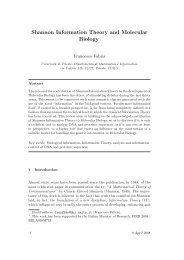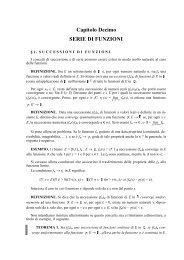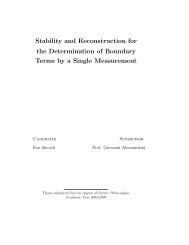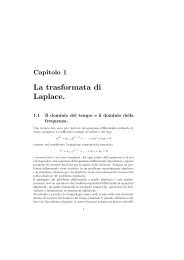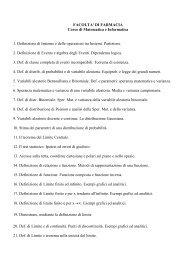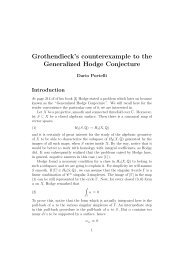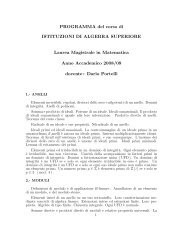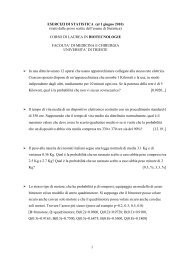INTRODUCTION TO ALGEBRAIC GEOMETRY Note del corso di ...
INTRODUCTION TO ALGEBRAIC GEOMETRY Note del corso di ...
INTRODUCTION TO ALGEBRAIC GEOMETRY Note del corso di ...
You also want an ePaper? Increase the reach of your titles
YUMPU automatically turns print PDFs into web optimized ePapers that Google loves.
40 Mezzetti<strong>Note</strong> that, by definition, 1 ♯ O(X) = 1 X, for all affine X; moreover (v◦u) ♯ = u ♯ ◦v ♯for all u : O(Z) → O(Y ), v : O(Y ) → O(X), K–homomorphisms of affine algebraicsets: this means that also this construction is functorial.9.5. Corollary. Let X, Y be affine algebraic sets. Then X ≃ Y if and only ifO(X) ≃ O(Y ).□If X and Y are quasi–projective varieties and φ : X → Y is regular, it is notalways possible to define a comorphism K(Y ) → K(X). If f is a rational functionon Y with domf = U, it can happen that φ(X) ∩ domf = ∅, in which case f ◦ φdoes not exist. Nevertheless, if we assume that φ is dominant, i.e. φ(X) = Y ,then certainly φ(X) ∩ U ≠ ∅, hence 〈φ −1 (U), f ◦ φ〉 ∈ K(X). We obtain a K–homomorphism, which is necessarily injective, K(Y ) → K(X), also denoted φ ∗ .<strong>Note</strong> that in this case, we have: <strong>di</strong>m X ≥ <strong>di</strong>mY . As above, it is possible to checkthat, if X ≃ Y , then K(X) ≃ K(Y ), hence <strong>di</strong>mX = <strong>di</strong>m Y . Moreover, if P ∈ Xand Q = φ(P), then φ ∗ induces a map O Q,Y → O P,X , such that φ ∗ M Q,Y ⊂ M P,X .Also in this case, if φ is an isomorphism, then O Q,Y ≃ O P,X .Let now X ⊂ P n be a quasi–projective variety and φ : X → P m be a map.9.6. Proposition. φ is a morphism if and only if, for all P ∈ X, there existan open neighbourhood U P of P and n + 1 homogeneous polynomials F 0 , . . ., F mof the same degree, in K[x 0 , x 1 , . . ., x n ], such that, if Q ∈ U P , then φ(Q) =[F 0 (Q), . . ., F m (Q)]. In particular, for all Q ∈ U P , there exists an index i suchthat F i (Q) ≠ 0.Proof. “ ⇒” Let P ∈ X, Q = φ(P) and assume that Q ∈ U 0 . Then U := φ −1 (U 0 )is an open neighbourhood of P and we can consider the restriction φ| U : U → U 0 ,which is regular. Possibly after restricting U, using non–homogeneous coor<strong>di</strong>nateson Y 0 , we can assume that φ| U = (F 1 /G 1 , . . ., F m /G m ), where (F 1 , G 1 ),. . ., (F m , G m ) are pairs of homogeneous polynomials of the same degree suchthat V P (G i ) ∩ U = ∅ for all index i. We can reduce the fractions F i /G i to acommon denominator F 0 , so that deg F 0 = deg F 1 = . . . = deg F m and φ| U =(F 1 /F 0 , . . ., F m /F 0 ) = [F 0 , F 1 , . . ., F m ], with F 0 (Q) ≠ 0 for Q ∈ U.“ ⇐” Possibly after restricting U P , we can assume F i (Q) ≠ 0 for all Q ∈ U Pand suitable i. Let i = 0: then φ| UP : U P → U 0 operates as follows: φ| UP (Q) =(F 1 (Q)/F 0 (Q), . . ., F m (Q)/F 0 (Q)), so it is a morphism by Proposition 9.3. Fromthis remark, one deduces that also φ is a morphism.□9.7. Examples.1. Let X ⊂ P 2 , X = V P (x 2 1 + x2 2 − x2 0 ), the projective closure of the unitary



